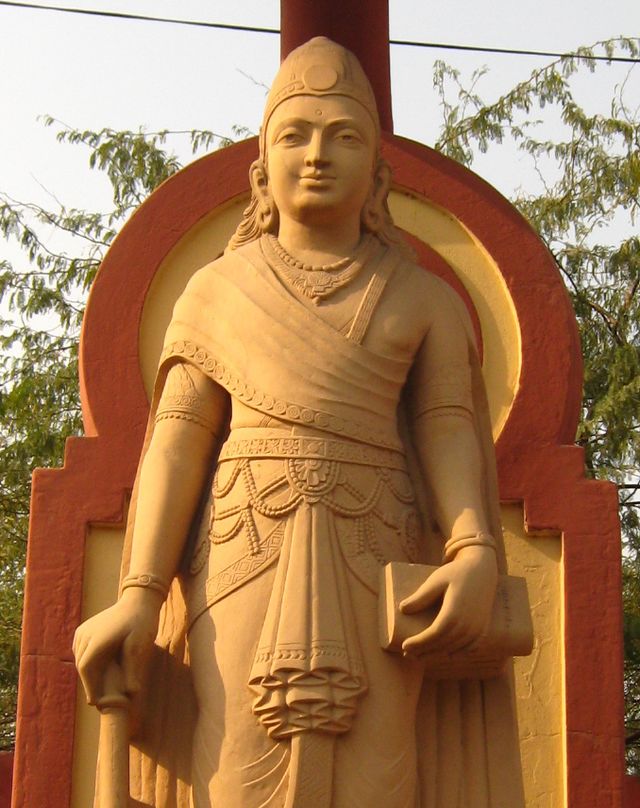Chandragupta Maurya: Difference between revisions - Wikipedia
 Article Images
Article Images
m
Line 23:
Chandragupta Maurya was a pivotal figure in the [[history of India]], laying the foundations of the first government to unite most of South Asia. Chandragupta, under the tutelage of Chanakya, created a new empire based on the principles of statecraft, built a large army, and continued expanding the boundaries of his empire until ultimately renouncing it for an ascetic life in his final years.
Prior to his consolidation of power, [[Alexander the Great]] had invaded the North-West Indian subcontinent before abandoning his campaign in 324 BCE due to a mutiny caused by the prospect of facing another large empire, presumably the [[Nanda Empire]]. Chandragupta defeated and conquered both the [[Nanda Empire]], and the Greek satraps that were appointed or formed from Alexander's Empire in [[South Asia]]. Chandragupta first gained regional prominence in the [[Greater Punjab]] region in the Indus. He then set out to [[Conquest of the Nanda Empire|conquer the Nanda Empire]] centered in [[Pataliputra]], [[Magadha]]. Afterwards, Chandragupta expanded and secured his western border, where he was confronted by [[Seleucus I Nicator]] in the [[Seleucid-Mauryan War]]. After two years of war, Chandragupta had gained the upper hand in the conflict and annexed satrapiesthe region up to the [[Hindu Kush]]. InsteadChandragupta ofimposed prolongingharsh thetreaties waron [[Seleucus I Nicator]], bothaccording partiesto settledwhich onSeleucus aI had to cede the marriageland treatyannexed betweenby Chandragupta andas [[Seleucuswell Ias Nicator]]had to give the hand of his daughter to Chandragupta.
Chandragupta's empire extended throughout most of the Indian subcontinent, spanning from modern day [[Bengal]] to [[Afghanistan]] across North India as well as making inroads into Central and South India. According to the Jain accounts dated to 800 years after his death, Chandragupta abdicated his throne and became a [[Jain monk]], traveled away from his empire to South India and committed [[sallekhana]] or fasting to death. Contemporary Greek evidence however avers that Chandragupta did not give up performing the rites of sacrificing animals associated with [[Vedic Brahminism]], an ancient form of Hinduism; he delighted in hunting and otherwise leading a life remote from the Jain practice of ''[[Ahimsa]]'' or nonviolence towards living beings.<ref name="India1960">{{citation|last1=Majumdar|first1=R. C.|authorlink1=R. C. Majumdar|last2=Raychauduhuri|first2=H. C.|authorlink2=H. C. Raychaudhuri|last3=Datta|first3=Kalikinkar|title=An Advanced History of India |url=https://books.google.com/books?id=MyIWMwEACAAJ|year=1960|publisher=Macmillan & Company Ltd; New York: St Martin's Press|location=London|quote=If the Jaina tradition is to be believed, Chandragupta was converted to the religion of Mahavira. He is said to have abdicated his throne and passed his last days at Sravana Belgola in Mysore. Greek evidence, however, suggests that the first Maurya did not give up the performance of sacrificial rites and was far from following the Jaina creed of ''Ahimsa'' or non-injury to animals. He took delight in hunting, a practice that was continued by his son and alluded to by his grandson in his eighth Rock Edict. It is, however, possible that in his last days he showed some predilection for Jainism ...}}</ref><ref>The authors and their affiliations listed in the title page of the reference (which has the Wikipedia page ''[[An Advanced History of India]]'') are: R. C. Majumdar, M.A., Ph.D. Vice-Chancellor, Dacca University; H. C. Raychaudhuri, M.A., Ph.D., Carmichael Professor of Ancient Indian History and Culture, Calcutta University; and Kalikinkar Datta, M.A., Ph.D. Premchand Raychand Scholar, Mount Medallist, Griffith Prizeman, Professor and Head of the Department of History, Patna College, Patna</ref> Chandragupta's reign, and the Maurya Empire, set an era of economic prosperity, reforms, infrastructure expansions, and tolerance. Many religions thrived within his realms and his descendants' empire. [[Buddhism]], [[Jainism]] and [[Ajivika]] gained prominence alongside [[Vedic]] and [[Brahmanism|Brahmanistic]] traditions, and minority religions such as [[Zoroastrianism]] and the [[Greek pantheon]] were respected. A memorial for Chandragupta Maurya exists on the [[Chandragiri hill]] along with a 7th-century hagiographic inscription.